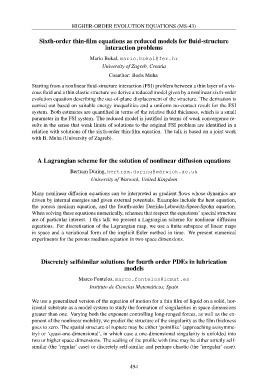Page 496 - 8th European Congress of Mathematics ∙ 20-26 June 2021 ∙ Portorož, Slovenia ∙ Book of Abstracts
P. 496
HIGHER-ORDER EVOLUTION EQUATIONS (MS-43)
Sixth-order thin-film equations as reduced models for fluid-structure
interaction problems
Mario Bukal, mario.bukal@fer.hr
University of Zagreb, Croatia
Coauthor: Boris Muha
Starting from a nonlinear fluid-structure interaction (FSI) problem between a thin layer of a vis-
cous fluid and a thin elastic structure we derive a reduced model given by a nonlinear sixth-order
evolution equation describing the out-of-plane displacement of the structure. The derivation is
carried out based on suitable energy inequalities and a uniform no-contact result for the FSI
system. Both estimates are quantified in terms of the relative fluid thickness, which is a small
parameter in the FSI system. The reduced model is justified in terms of weak convergence re-
sults in the sense that weak limits of solutions to the original FSI problem are identified in a
relation with solutions of the sixth-order thin-film equation. The talk is based on a joint work
with B. Muha (University of Zagreb).
A Lagrangian scheme for the solution of nonlinear diffusion equations
Bertram Düring, bertram.during@warwick.ac.uk
University of Warwick, United Kingdom
Many nonlinear diffusion equations can be interpreted as gradient flows whose dynamics are
driven by internal energies and given external potentials. Examples include the heat equation,
the porous medium equation, and the fourth-order Derrida-Lebowitz-Speer-Spohn equation.
When solving these equations numerically, schemes that respect the equations’ special structure
are of particular interest. I this talk we present a Lagrangian scheme for nonlinear diffusion
equations. For discretisation of the Lagrangian map, we use a finite subspace of linear maps
in space and a variational form of the implicit Euler method in time. We present numerical
experiments for the porous medium equation in two space dimensions.
Discretely selfsimilar solutions for fourth order PDEs in lubrication
models
Marco Fontelos, marco.fontelos@icmat.es
Instituto de Ciencias Matemáticas, Spain
We use a generalized version of the equation of motion for a thin film of liquid on a solid, hor-
izontal substrate as a model system to study the formation of singularities in space dimensions
greater than one. Varying both the exponent controlling long-ranged forces, as well as the ex-
ponent of the nonlinear mobility, we predict the structure of the singularity as the film thickness
goes to zero. The spatial structure of rupture may be either ‘pointlike’ (approaching axisymme-
try) or ‘quasi-one-dimensional’, in which case a one-dimensional singularity is unfolded into
two or higher space dimensions. The scaling of the profile with time may be either strictly self-
similar (the ‘regular’ case) or discretely self-similar and perhaps chaotic (the ‘irregular’ case).
494
Sixth-order thin-film equations as reduced models for fluid-structure
interaction problems
Mario Bukal, mario.bukal@fer.hr
University of Zagreb, Croatia
Coauthor: Boris Muha
Starting from a nonlinear fluid-structure interaction (FSI) problem between a thin layer of a vis-
cous fluid and a thin elastic structure we derive a reduced model given by a nonlinear sixth-order
evolution equation describing the out-of-plane displacement of the structure. The derivation is
carried out based on suitable energy inequalities and a uniform no-contact result for the FSI
system. Both estimates are quantified in terms of the relative fluid thickness, which is a small
parameter in the FSI system. The reduced model is justified in terms of weak convergence re-
sults in the sense that weak limits of solutions to the original FSI problem are identified in a
relation with solutions of the sixth-order thin-film equation. The talk is based on a joint work
with B. Muha (University of Zagreb).
A Lagrangian scheme for the solution of nonlinear diffusion equations
Bertram Düring, bertram.during@warwick.ac.uk
University of Warwick, United Kingdom
Many nonlinear diffusion equations can be interpreted as gradient flows whose dynamics are
driven by internal energies and given external potentials. Examples include the heat equation,
the porous medium equation, and the fourth-order Derrida-Lebowitz-Speer-Spohn equation.
When solving these equations numerically, schemes that respect the equations’ special structure
are of particular interest. I this talk we present a Lagrangian scheme for nonlinear diffusion
equations. For discretisation of the Lagrangian map, we use a finite subspace of linear maps
in space and a variational form of the implicit Euler method in time. We present numerical
experiments for the porous medium equation in two space dimensions.
Discretely selfsimilar solutions for fourth order PDEs in lubrication
models
Marco Fontelos, marco.fontelos@icmat.es
Instituto de Ciencias Matemáticas, Spain
We use a generalized version of the equation of motion for a thin film of liquid on a solid, hor-
izontal substrate as a model system to study the formation of singularities in space dimensions
greater than one. Varying both the exponent controlling long-ranged forces, as well as the ex-
ponent of the nonlinear mobility, we predict the structure of the singularity as the film thickness
goes to zero. The spatial structure of rupture may be either ‘pointlike’ (approaching axisymme-
try) or ‘quasi-one-dimensional’, in which case a one-dimensional singularity is unfolded into
two or higher space dimensions. The scaling of the profile with time may be either strictly self-
similar (the ‘regular’ case) or discretely self-similar and perhaps chaotic (the ‘irregular’ case).
494


